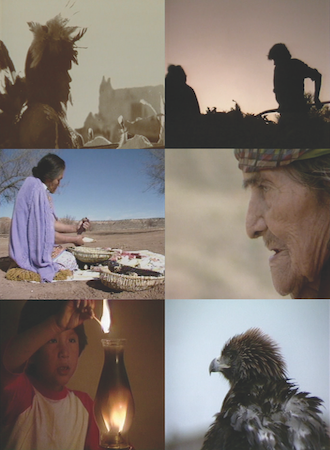
Itam Hakim Hopiit 1984
Distributed by Documentary Educational Resources, 108 Water Street, 5A, Watertown, MA 02472; 617-926-0491
Produced by Victor Masayesva, Jr.
Directed by Victor Masayesva, Jr.
Streaming, 58 mins
Middle School - General Adult
Multiculturalism; Native Americans; Storytelling
Date Entered: 03/20/2023
Reviewed by Joseph Baumstarck, Jr., Adjunct Professor - Ivy Tech Community College and Independent ScholarItam Hakim Hopiit is a documentary filmed in 1980 during the Hopi tricentennial celebration of their successful revolt against Spanish rule. It was completed and released in 1984. The film depicts one of the last surviving elders from his Hopi clan, Ross Macaya, telling some of the creation stories, stories of struggle against the Spanish and other forces, and Bow Clan migration stories, in a traditional Hopi manner using the Hopi language. The stories are woven together like traditional Native American storytellers tend to weave stories from different times and places into an apparently unified whole. An attentive listener can gain a basic understanding of the struggles of the Hopi people, especially versus the Spanish, and a sense of their visions of their origins. The cinematography and music set a mood that gives the listener a sense of traditional Hopi storytelling. The cinematography is, at times, successful but is overall dull and colorless. There are brief moments of desert beauty and Hopi culture and everyday life that succeed at setting the tone. Too bad these are too few and far between. The music is primarily traditional Hopi, with significant portions depicting drumming. The music does a better job of placing the listener in the Hopi culture than the video images.
The stories are narrated in Hopi with an English voice-over. The voice-over does a decent job of letting the listener follow what is said and attempts to translate not only the basic meaning but the nuance and rhythm of Hopi. The Hopi is still clearly discernable in the background, and a Hopi-fluent listener could hear the stories in Hopi.
The last portion of the film depicts the pow-wow and ceremonies surrounding the tricentennial celebration. For some reason, a large portion of this is fast-forwarded, which makes this section lose much of its appeal. Allowing the ceremonies to speak more clearly and for a longer time during the film would have significantly enhanced the cinematography and made the cinematography more relevant.
Given the abovementioned negatives, a Recommended With Reservations rating is appropriate. The datedness of this film does not really detract significantly from its value since the narrated stories are much older than the few decades since the film launched. The value of the stories is the same today as it was in 1984, hundreds of years earlier, or hundreds of years in the future. The projected audience for this film is quite small. Although filmed at a level even smaller children could listen to and understand the stories, not many modern American children, except some Native American children, are trained and ready to listen to stories told in this manner. It is doubtful that many Native American communities, including Hopi ones, would be interested in this film since the storytelling traditions in these cultures continue today with modern elders telling these stories in their ways to their people. For academics, the primary audience is Native American studies and some multicultural Humanities programs. While reviewing this film, I could not miss the similarities between the stories told in it and some of the Ossianic heroic verses and songs regarding Finn MacCumhill or Fingal in Scottish literature. Although Scottish literature focuses on a particular hero and the Hopi stories lack an individual as a focus, the clan aspects, things discussed in the stories, and underlying philosophies are very similar. This would be an interesting focus for a comparative literature course, intersecting Native American and Scottish/Medieval European storytelling.
Awards:Gold Hugo Award at the 1984 Chicago International Film Festival; Inducted into the Library of Congress' National Film Registry in 2022 for being “culturally, historically, or aesthetically significant.”
Published and licensed under the Creative Commons Attribution 4.0 license. Anyone can use these reviews, so long as they comply with the terms of the license.